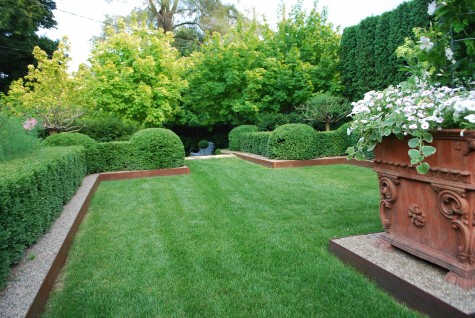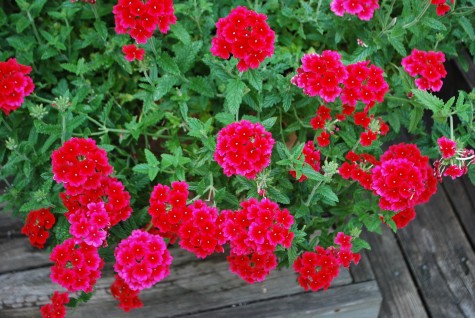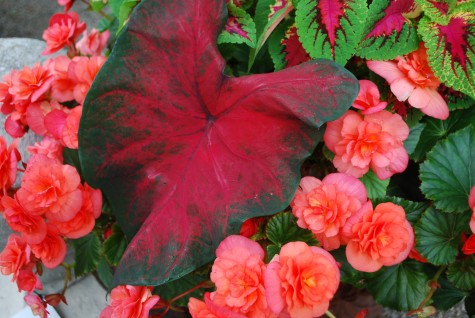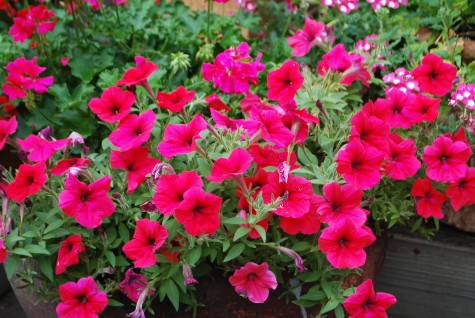Archives for July 2010
At A Glance 2: Making That Red Work
On The Verge
 A verge is the absolute boundary between one space and another. The Brits call the edges on their garden beds “verges”. Years ago, taking the time to cut clean deep edges on beds with a sharp square spade for clients, asked for a name with some romance. Cuuting a verge made me feel like I was doing important work. Edging beds-not so much fun. I would fill those verge ditches with bark-to keep the grass from invading. Edging beds and walks with steel or aluminum edging is an expensive investment that dramatically lowers maintenance time over the lifetime of a landscape. In this garden, I had no interest in grass invading the gravel walks. A steel verge keeps the spaces cleanly different. Grass meets gravel. Grass and gravel coexist beautifully.
A verge is the absolute boundary between one space and another. The Brits call the edges on their garden beds “verges”. Years ago, taking the time to cut clean deep edges on beds with a sharp square spade for clients, asked for a name with some romance. Cuuting a verge made me feel like I was doing important work. Edging beds-not so much fun. I would fill those verge ditches with bark-to keep the grass from invading. Edging beds and walks with steel or aluminum edging is an expensive investment that dramatically lowers maintenance time over the lifetime of a landscape. In this garden, I had no interest in grass invading the gravel walks. A steel verge keeps the spaces cleanly different. Grass meets gravel. Grass and gravel coexist beautifully.

Steel or aluminum edging shines on a terrace made of multiple materials. The extreme boundary of the gravel portion of this terrace is equal to the extreme boundary of the brick portion of this terrace. The transition space-probably 1/8th of an inch wide. A very crisp verge dresses up a space.

Lawn and decomposed granite share one tendency-they both will spread out and blur the edges of the shape of a space, unless contained. Blurred edges suit some landscapes. I love those English style perennial gardens where the gravel is actually a mulch. You know of which I speak-those perennials billowing over the gravel in a pattern much about plant habit, and that one random perennial thriving in the gravel. The seed that managed to germinate, the plant that managed to take hold in the gravel, the gardener that directs all traffic around that one volunteer so beautifully out of place-this garden has no use for verges. This particular design-aluminum verging was a must.
 My steel bench sits on a platform set at exactly the height of my pool coping. That platform is edged in steel. I like the pool and bench platform set some above the lawn panel. The why is simple. I am very interested in the description that landscape makes of the ground plane. Multiple ground planes I find interesting. Rather than ascribe this to an estoteric aesthetic ,living on minutae, I would suggest a bigger picture. The lay of the land is a very important part of the beauty of a landscape. Work the sculpture that is the ground- before you plant.
My steel bench sits on a platform set at exactly the height of my pool coping. That platform is edged in steel. I like the pool and bench platform set some above the lawn panel. The why is simple. I am very interested in the description that landscape makes of the ground plane. Multiple ground planes I find interesting. Rather than ascribe this to an estoteric aesthetic ,living on minutae, I would suggest a bigger picture. The lay of the land is a very important part of the beauty of a landscape. Work the sculpture that is the ground- before you plant.
 My stone retaining walls are edges, verges, on a much bigger and more noticeable scale. Edging makes a dramatic change of material possible in a subtle way. The changes of grade in my garden are no doubt my most favorite thing about it. I think my landscape would be just as beautiful planted with grass everywhere, as it is now. Picture your entire property planted with grass-would it enchant you? If not, look at how you have sculpted your ground. Start with a beautifully sculptural ground plane. A great landscape design will feature the underlying structure of your land.
My stone retaining walls are edges, verges, on a much bigger and more noticeable scale. Edging makes a dramatic change of material possible in a subtle way. The changes of grade in my garden are no doubt my most favorite thing about it. I think my landscape would be just as beautiful planted with grass everywhere, as it is now. Picture your entire property planted with grass-would it enchant you? If not, look at how you have sculpted your ground. Start with a beautifully sculptural ground plane. A great landscape design will feature the underlying structure of your land.
 My side city half lot is very small. I dug out the ground plane-I thought a sunken garden would be the most significant gesture I might make in a small space. Lowering the ground 8 inches-I had to go to Buck for edging for retaining that lowered space. I had no room to roll and feather down to the lower level. He made thick steel edging for me some 11″ wide. And the corners, stakes, and connectors to go with. Photographing from the fountain garden grade, you can see what my low riding corgis see every day-a gorgeous change of grade.
My side city half lot is very small. I dug out the ground plane-I thought a sunken garden would be the most significant gesture I might make in a small space. Lowering the ground 8 inches-I had to go to Buck for edging for retaining that lowered space. I had no room to roll and feather down to the lower level. He made thick steel edging for me some 11″ wide. And the corners, stakes, and connectors to go with. Photographing from the fountain garden grade, you can see what my low riding corgis see every day-a gorgeous change of grade.
 The steel platform for my English concrete pot is new this year. The 1/4 inch hot rolled, pickled and oiled steel is still that blue- grey color. It will not take long to rust up, and turn brown. This landscape-very simply about the sculpture that is the ground. Sculpture in the landscape is important to me personally. Knowing what is important to you in your landscape is incredibly important before you dig any holes.
The steel platform for my English concrete pot is new this year. The 1/4 inch hot rolled, pickled and oiled steel is still that blue- grey color. It will not take long to rust up, and turn brown. This landscape-very simply about the sculpture that is the ground. Sculpture in the landscape is important to me personally. Knowing what is important to you in your landscape is incredibly important before you dig any holes.
 I have lived in my house, on this property, some 15 years. My small 1.5 city lot plot demanded much more thought than action. I am happy with my verges, no matter where they might be. The edges of a landscape composition are very important. Painters-they are so lucky to have that frame around what they paint. Landscape design-the edges need to be discovered, and marked. This process can take a lot of time. Lucky for every gardener, the earth has much more time than you do. Nature favors any work you do, in the long run.
I have lived in my house, on this property, some 15 years. My small 1.5 city lot plot demanded much more thought than action. I am happy with my verges, no matter where they might be. The edges of a landscape composition are very important. Painters-they are so lucky to have that frame around what they paint. Landscape design-the edges need to be discovered, and marked. This process can take a lot of time. Lucky for every gardener, the earth has much more time than you do. Nature favors any work you do, in the long run.
This raised grass panel, beautifully edged in steel, is not my design. My client’s interior designer engineered this for her. He may not know the verge word, but he understands everything about space and sculpture, does he not?
Sweet Verbena

Sweet plants-you know what I mean. No landscape can be structured around them. Unless you are up close, you might not notice them. Should you have a cottage garden, your best view of your sweet plants are when you cut and place them in a vintage milk bottle on the table. Sweet plants are lax growing, weedy-gorgeously natural. Some sweet plants are so sweet, they do not last cut more than a few hours. The British version of Country Living magazine-I treasure every issue. The Brits grow every sweet plant successfully in their mild climate-how I so envy them their endless varieites of snowdrops, the auricula primroses, the frittilarias, the columbines, the Noisette roses, the belladonna and bellamosa delphiniums-all of those sweet plants who would black out and fall to the ground weeping in my midwestern garden. But we have a few plants available that can satisfy a midwestern gardener’s sweet tooth.

Trailing verbena-sweet. For years I avoided growing them. Prone to mildew and every other fungal disases affecting plants-who has time for this? Recent breeding has vastly improved the disease resistance of this class of annual plants. I gave them a second look. My garden will never ever remotely resemble a beautifully graceful English garden. Can you hear me sigh? The trailing verbenas are a plant group I would recommend-should a little dose of sweet suit you. They endow my garden with a little bit of that English country garden I so love.
 They come in a wide range of colors. White, lavender, lavender star, purple, royal purple-the list is long. The Lanai series is my favorite-these cultivars are amazingly disease resistant, heavy blooming, and long lived. My trailing verbenas last long into the fall, given proper culture.
They come in a wide range of colors. White, lavender, lavender star, purple, royal purple-the list is long. The Lanai series is my favorite-these cultivars are amazingly disease resistant, heavy blooming, and long lived. My trailing verbenas last long into the fall, given proper culture.
 This cherry red verbena-new to me. I have no name to pass on. It is more upright than most. I am only able to water my pots once a day-when I get home. Should it be 95 degrees all day, they may wilt down, but this verbena does not expire. The sweet chery verbena has a will of iron to survive. Sweet plants with a formidable will to live-keep them.
This cherry red verbena-new to me. I have no name to pass on. It is more upright than most. I am only able to water my pots once a day-when I get home. Should it be 95 degrees all day, they may wilt down, but this verbena does not expire. The sweet chery verbena has a will of iron to survive. Sweet plants with a formidable will to live-keep them.
 Lanai verbena lavender star is my favorite trailing verbena. The white and lavender star mix in the blooms makes for a very showy addition to any container planting. I have had them performing as late as October-no kidding. I have been so bold as to plant trailing verbenas in ground-they do great. Should you commit to these plants-be advised. They need to have their dead flower heads removed regularly. Maybe daily. Should you be a once a week gardener, please disregard my enchantment with verbena. If you keep up with the deaheading, thiese plants will reward your garden.
Lanai verbena lavender star is my favorite trailing verbena. The white and lavender star mix in the blooms makes for a very showy addition to any container planting. I have had them performing as late as October-no kidding. I have been so bold as to plant trailing verbenas in ground-they do great. Should you commit to these plants-be advised. They need to have their dead flower heads removed regularly. Maybe daily. Should you be a once a week gardener, please disregard my enchantment with verbena. If you keep up with the deaheading, thiese plants will reward your garden.
 Sweet plants cozy up to other plants in their neighborhood. They never mean to imply they are the star of the show. They wrote the book on what it means to be a member of a community. Sweet and unassuming they are. But I love how they grow vigorously, and horizontally, and bloom heavily. They weave in and out of whatever else is in their neighborhood. So sweet, and so persistent. They take on, and grow up in concert with, any number of neighbors. This I like about them.
Sweet plants cozy up to other plants in their neighborhood. They never mean to imply they are the star of the show. They wrote the book on what it means to be a member of a community. Sweet and unassuming they are. But I love how they grow vigorously, and horizontally, and bloom heavily. They weave in and out of whatever else is in their neighborhood. So sweet, and so persistent. They take on, and grow up in concert with, any number of neighbors. This I like about them.

New trailing verbena varieties-this bicolor version is an example. I have no opinion about it-I am trying it for the first time this season. Successful gardening is much about trying plants that are new to you. Some you will give a berth in your garden. I watch and assess everything that goes into the ground in my garden. Given my small space, why shouldn’t I? The sweet plants-they will not carry me to the other side. But when they are good, they are very very good. Have some gardening room for some sweet?
Plant them-those sweet verbenas.



















